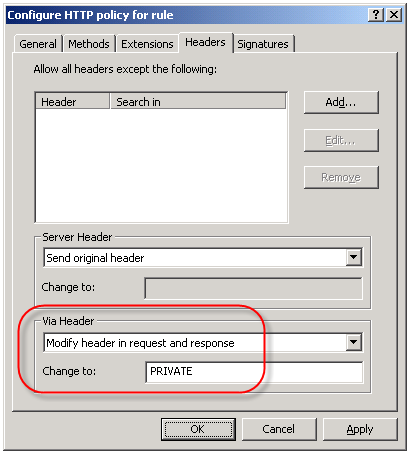Using the ISA HTTP Filter To Modify Via Headers And Prevent Information Disclosure
The ISA firewall’s powerful HTTP filter allows us to inspect and modify HTTP request and response headers at a very granular level. The HTTP filter by default will allow only valid, RFC compliant HTTP communication to pass through it, and it will also limit the length of request headers. The HTTP filter is highly configurable though, allowing us to control which types of HTTP methods are allowed, which file extensions are allowed, which request or response headers are allowed, as well as giving us the ability to block content containing specific signatures defined by the ISA firewall administrator. Most often these advanced inspection features are used to block specific content using HTTP, such as instant messaging or peer-to-peer applications, or to prevent certain types of attacks against our systems by searching for and blocking communication based on a given string contained in request and response headers and bodies
An often overlooked use of the HTTP filter is the ability to control the HTTP Via header. The HTTP Via header is required when a proxy intermediates requests between a user and a remote host (http://www.w3.org/Protocols/rfc2616/rfc2616-sec14.html – section 14.45). By default, the HTTP filter sends the default header, which is the hostname of the ISA firewall that handled the request. Since the hostname of your ISA firewall could (and should) be considered sensitive information, it is a good idea to configure the HTTP filter to send something other than the default header. This is accomplished by right-clicking on each access rule that includes HTTP as a defined protocol and choosing ‘Configure HTTP’. Select the ‘Headers’ tab, then select the option to ‘Modify header in request and response’. In the ‘Change to:’ field, enter something ambiguous. Typically I enter ‘PRIVATE’. If you have multiple ISA firewalls handling outbound Internet communication you may wish to choose something that is ambiguous but still allows you to identify which firewall processed the request, such as FW1.

-
April 22, 2009 at 6:18 amThomas Shinder Blog » Blog Archive » Using the ISA HTTP Filter To Modify Via Headers And Prevent Information Disclosure




